Sandy Bridge Memory Scaling: Choosing the Best DDR3
by Jared Bell on July 25, 2011 1:55 AM EST3DMark 11
We're going to start the graphics benchmarks with the synthetic 3DMark test. The latest version, 3DMark 11, is still very GPU dependent. However, it does include a CPU Physics test and a combined graphics/physics test for simulating those types of loads. We’ll use the overall score with the three subtests to see if we can find any areas where memory performance makes a noticeable difference.
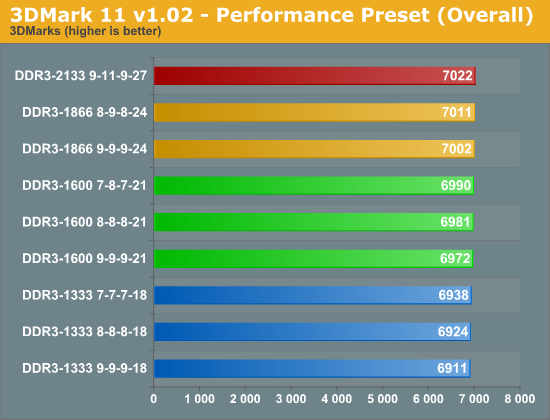
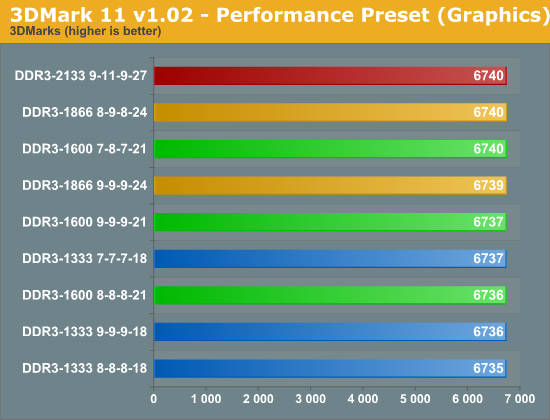
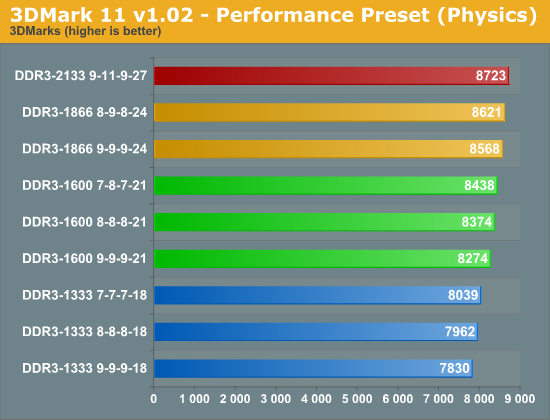
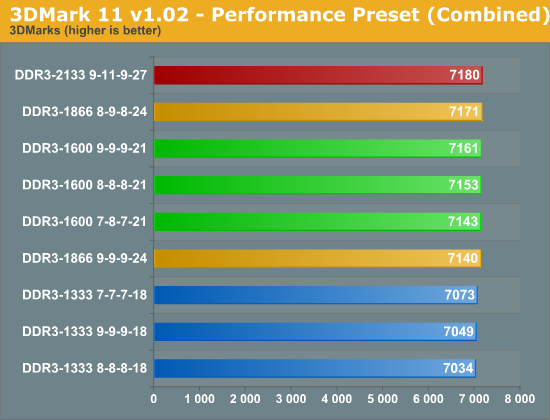
The overall score, which is heavily based on the graphics tests, shows a mere ~1% change across the board. When you get to the graphics test, you can see that the faster memory makes absolutely no difference at all. It's not until we get to the physics test where we see some improvement from increasing the memory speed. We get performance boost of up to 11% when going from DDR3-133 to DDR3-2133. The combined test entails the rendering of a 3D scene with the GPU while performing physics tasks on the CPU. Here again, were see a very small 2% increase in performance from the slowest to the fastest.
Crysis and Metro 2033
Based on 3DMark 11, then, we’d expect most games to show very little improvement from upgrading your memory, but we ran several gaming benchmarks just to be sure. I decided to combine the analysis for Crysis: Warhead and Metro 2033 due to the virtually non-existent differences observed during these tests. Crysis: Warhead was the previous king of the hill when it came to bringing video cards to their knees. The newer kid on the block, Metro 2033, has somewhat taken over that throne. Just how do they react to the various memory configurations we're testing today?
It's worth noting that the settings used here are the settings that I would actually play these games at: 1920x1080 with most of the high quality features enabled. Frame rates are well above 30, so definitely playable, though they’re below 60 so some would say they’re not perfectly smooth. Regardless, unless you play at settings where your GPU isn’t the primary bottleneck, you should see similar scaling from memory performance.
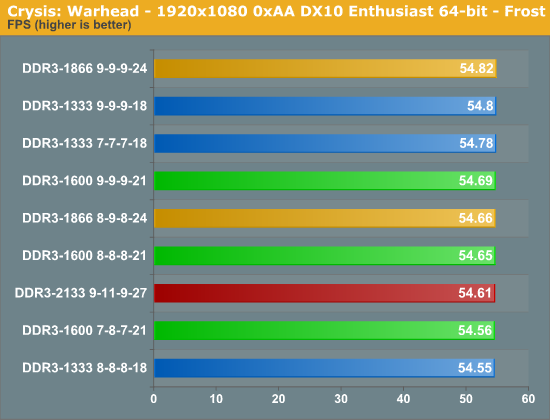
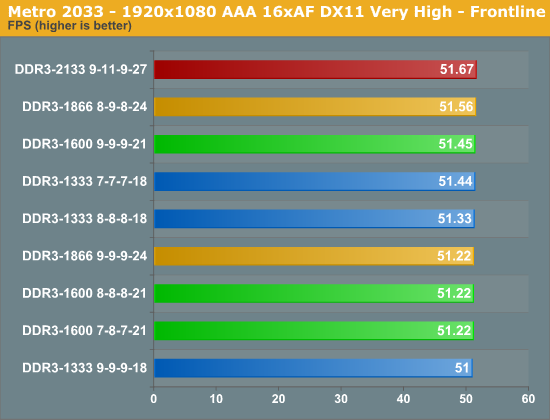
The results weren't very stimulating, were they? Just as expected, gaming with faster memory just doesn't make any notable difference. I could have potentially lowered the resolution and settings in an attempt to produce some sort of difference, but I felt that testing these games at the settings they're most likely to be played at was far more enlightening. If you want better gaming performance, the GPU is the best component to upgrade—no news there.










76 Comments
View All Comments
Rick83 - Monday, July 25, 2011 - link
Do they take into account, that we should be using 1.5V DIMMs for Sandy Bridge?The addition of that requirement usually limits choice quite a bit.
compudaze - Monday, July 25, 2011 - link
The SNB datasheet does suggest that the max memory voltage is 1.575V, however, many motherboard and memory manufactures state that they haven't had any problems with memory running at 1.65V on SNB.compudaze - Monday, July 25, 2011 - link
Also, if you stick to the spec sheet, you shouldn't be running faster than DDR3-1333 memory.Taft12 - Monday, July 25, 2011 - link
You should be using 1.5V DIMMs anyway - if a memory OEM needs 1.65V to achieve the same speed and timings another vendor does at 1.5V, it's inferior memory.jdogi - Monday, July 25, 2011 - link
Just as your daily driver vehicle is likely inferior to a Mercedes or Ferrari. You should get a new car. You should not make any attempt to balance cost with the value. Just get the best. It's the only way to go. What's best for Taft is best for all.;-)
Iketh - Tuesday, July 26, 2011 - link
you didn't understand the logicMrSpadge - Wednesday, July 27, 2011 - link
I'm sure he did. What Taft failed to mention was that "at the same price, you should be using the memory spec'ed for less voltage". However, if some memory needs a little more voltage, but is way cheaper - balance cost and value.MrS
Rick83 - Wednesday, July 27, 2011 - link
Actually, the higher voltage is out of spec for the CPU memory controller and may wel impact longevity.So it's like buying the Ferrari, and running it on Biofuel with too much Ethanol that eats right through the tubing, but is marginally cheaper.
jfelano - Tuesday, July 26, 2011 - link
Not inferior, just older. All 1600mhz memory was 1.65v when it debuted. Then they came out with 1.5v, now even 1.35v.cervantesmx - Thursday, July 28, 2011 - link
That is correct indeed. Just purchased 8GB at 1600mhz running on 1.25v. $59.99. Free shipping.